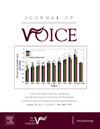Effect of Voice Therapy as a Supplement After Reinnervation Surgery for Breathy Dysphonia Due to Unilateral Vocal Fold Paralysis
IF 2.4
4区 医学
Q1 AUDIOLOGY & SPEECH-LANGUAGE PATHOLOGY
引用次数: 0
Abstract
Objective
To evaluate whether vocal function exercises (VFE) could be an adjunct treatment for patients with unilateral vocal fold paralysis (UVFP) who were not satisfied with their postoperative voices after reinnervation surgeries.
Study Design
Retrospective.
Methods
Medical records of the patients with UVFP who underwent laryngeal reinnervation between October 2011 and October 2014 were reviewed. Patients were classified into two groups: one received VFE according to patients’ desire (VFE group) and the other did not have voice therapy (control group). Effects of VFE were assessed by vocal fold vibration (regularity, amplitude and glottal gap), aerodynamic measurements (maximum phonation time (MPT) and mean airflow rate (MFR)), GRBAS scale, acoustic parameters (pitch range, pitch perturbation and amplitude perturbation quotients (PPQ, APQ), and noise-to-harmonics ratio (NHR)) and subjective evaluation by patients (Voice Handicap Index-10 (VHI-10)). Phonatory function was also compared between the two groups at three time points: before reinnervation surgery, before VFE, and after VFE.
Results
Thirty patients were enrolled (11 men, 19 women). The VFE group included eight patients, and 22 patients served as controls. In the VFE group, several parameters (amplitude, MPT, MFR, pitch range, APQ, and NHR) did not improve significantly after surgery, while all parameters examined improved significantly in the control group. After VFE, amplitude, glottal gap, MFR, B score, pitch range, and PPQ showed significant improvement, while the control group did not show a significant improvement except in VHI-10, during the corresponding period. Significant differences in G and B scores and VHI-10 between the two groups were observed at the third time point.
Conclusions
VFE may be used as an adjunct treatment for patients with UVFP who are not satisfied with their voices after reinnervation surgery. However, phonatory function after VFE may not reach the same level as for those who are satisfied with their voices after reinnervation surgery.
嗓音治疗对因单侧声带褶皱麻痹导致的呼吸困难的再神经手术后的辅助治疗效果。
目的评估声带功能锻炼(VFE)是否可作为单侧声带麻痹(UVFP)患者在神经再支配手术后对术后嗓音不满意的一种辅助治疗方法:研究设计:回顾性:回顾性分析 2011 年 10 月至 2014 年 10 月期间接受喉神经再支配手术的单侧声带麻痹患者的病历。患者被分为两组:一组根据患者意愿接受 VFE(VFE 组),另一组不进行语音治疗(对照组)。通过声带振动(规则性、振幅和声门间隙)、空气动力学测量(最大发音时间(MPT)和平均气流率(MFR))、GRBAS量表、声学参数(音域、音高扰动和振幅扰动商数(PPQ、APQ)和噪声-谐波比(NHR))以及患者的主观评价(嗓音障碍指数-10(VHI-10))来评估 VFE 的效果。还比较了两组患者在三个时间点的发音功能:神经再支配手术前、VFE 前和 VFE 后:结果:30 名患者(11 名男性,19 名女性)接受了手术。结果:共招募了 30 名患者(男性 11 人,女性 19 人),其中 VFE 组有 8 名患者,对照组有 22 名患者。在 VFE 组中,一些参数(振幅、MPT、MFR、音程、APQ 和 NHR)在术后没有明显改善,而在对照组中,所有检查参数都有明显改善。VFE 术后,除 VHI-10 外,振幅、声门间隙、MFR、B 评分、音程和 PPQ 均有明显改善,而对照组在相应时间内没有明显改善。在第三个时间点,两组之间的 G 和 B 评分以及 VHI-10 有明显差异:结论:对于接受神经再支配手术后对嗓音不满意的 UVFP 患者,VFE 可作为一种辅助治疗方法。然而,VFE 后的发音功能可能无法达到那些对神经再支配手术后的嗓音感到满意的患者的水平。
本文章由计算机程序翻译,如有差异,请以英文原文为准。
求助全文
约1分钟内获得全文
求助全文
来源期刊

Journal of Voice
医学-耳鼻喉科学
CiteScore
4.00
自引率
13.60%
发文量
395
审稿时长
59 days
期刊介绍:
The Journal of Voice is widely regarded as the world''s premiere journal for voice medicine and research. This peer-reviewed publication is listed in Index Medicus and is indexed by the Institute for Scientific Information. The journal contains articles written by experts throughout the world on all topics in voice sciences, voice medicine and surgery, and speech-language pathologists'' management of voice-related problems. The journal includes clinical articles, clinical research, and laboratory research. Members of the Foundation receive the journal as a benefit of membership.
 求助内容:
求助内容: 应助结果提醒方式:
应助结果提醒方式:


